Mortarless Stone Veneer
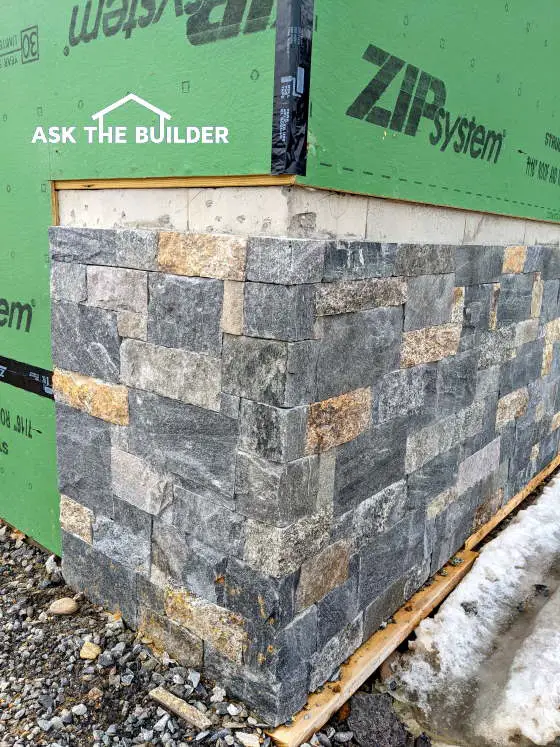
Mortarless Stone Veneer | With the quality of workmanship dropping like a bomb, maybe you should consider a stone veneer that has no mortar. Copyright 2022 Tim Carter
Mortarless Stone Veneer - It's a Time-Tested Product
Do you follow trends in design, building, clothes, etc.? You do realize the primary motivation behind these changing trends is to pry hard-earned money from your wallet or savings account. Are you old enough to remember when pink and gray ceramic tile was the rage? How about polka-dot patterned shirts with wide collars and bell-bottom jeans? I know, I’m dating myself!
Who First Used Mortarless Stone Veneer?
But what about a trend that started out within the past decade and appears to still be gaining in popularity? I’m talking about mortarless stone veneer. You may think this is a new technology, but it’s not. Not by a long shot. The Egyptians used this on a huge scale in Giza, home of the great pyramids and bed sheets. The giant pyramids had a smooth stone veneer of giant slabs of stone fitted with absolutely no mortar.
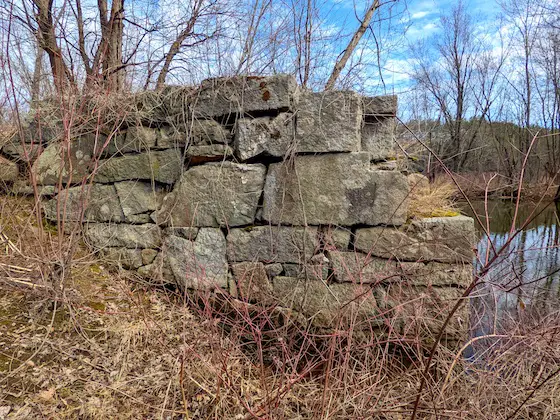
New Hampshire railroad builders also used mortarless stone! This bridge abutment is on the north shore of the Smith River just before it connects to the Pemigewasset River on the abandoned Boston & Maine railroad line that connected Bristol, NH to Franklin, NH. This abutment was constructed before the US Civil War known by Southerners as the War of Northern Aggression.
The Peruvian Indians did the same thing at Machu Picchu high up in the Andes Mountains thousands of years ago. It’s important to realize they did this with no power tools, no diamond wet saws, or dry-cut abrasive blades attached to a hand-held saw.
These two civilizations were not alone. There are plenty of examples of stone walls, buildings, arches, etc. all built without mortar. Instead, the master stonemasons took the time to fit the stones together much like the pieces of a high-quality jigsaw puzzle. The good news is you can purchase stone veneer for your home and follow in the footsteps of the master builders of old!
Use Stone Veneer Around Fireplaces
Recently a woman, who tunes into my live streaming video on my Ask the Builder YouTube channel each weekday, shared how she’s using thin pieces of interlocking colorful natural stone as a surround for her new fireplace. The old fireplace developed a crack in the firebox and had to be replaced. What’s interesting is the hearth and the wall above the fireplace was covered with large pieces of multi-colored slate that is not being replaced. The new stone veneer around the fireplace blends really well with the existing slate. Don’t be afraid to mix different stones, textures, and sizes.
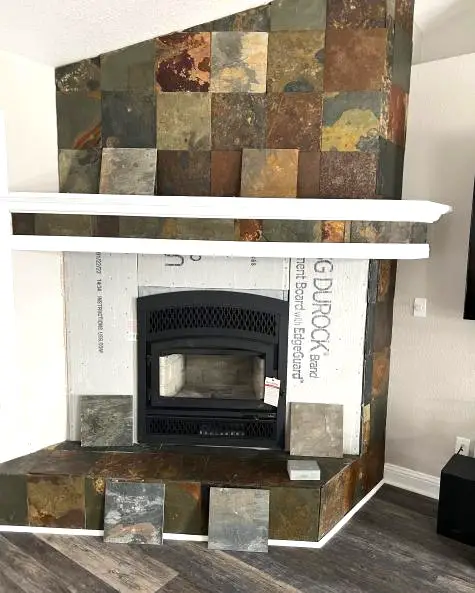
The mortarless stone veneer is going to go where you see the white cement board.
Months ago, a close friend of mine inherited an ocean-front condominium in southern California built 40-plus years ago. The interior fireplace had a dated tile surround and it was time to replace the tired tile. He and his wife chose to use the thin mortarless stone veneer that she installed. The color was fabulous and the 1.5-inch-high pieces of stone were the perfect scale to match both the room and the fireplace. She told me after the job was finished how easy it was to work with the stone.
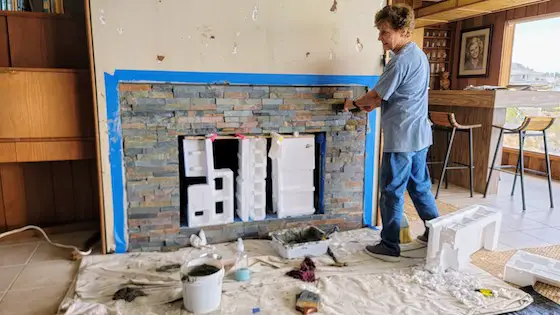
This is the woman who installed the stone veneer around her fireplace in the condominium. This was her first time working with the material and she did an outstanding job!
Keep in mind this amazing building material can be used outdoors with great success so long as you install it correctly. Just a few miles from my home, a new building sports a mortarless stone veneer that’s about 1.5 inches thick. The pieces of natural granite have a random texture that’s exposed to the weather.
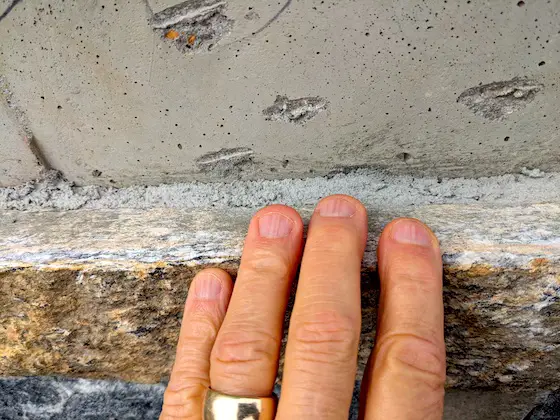
This mortarless stone veneer is on a building close to my home. It's about 1.5 inches thick. Regular brick mortar was used to adhere it to the cast/poured concrete foundation wall. Copyright Tim Carter 2022
What Are the Sizes of the Stones?
While it looks like the stone pieces are random in size, they’re not. The different sizes have been saw cut at a factory to precise heights so you can stack the stones randomly and never worry about a pesky gap. It’s very similar to an Ashlar pattern in slate flooring.
There are different ways to install these magic stone veneers. Some come as panels that you screw to the wall. Others are individual pieces of stone you adhere to an interior or exterior wall with Portland-cement-based thinset or traditional brick mortar applied to the back of each piece of stone. If you use traditional mortar, be sure to add some hydrated lime. I have a time-tested formula for this I'm happy to share with you.
How Heavy is Stone Veneer?
Keep in mind the cumulative weight of the stone veneer is quite heavy. Most natural stone weighs in at about 150 pounds per cubic foot. The stone that surrounds the two fireplaces I previously discussed could easily weigh about 600 pounds. This means as you install the stone, the first course needs to be solid and able to support the weight of the stone as you stack them.
What is the Best Way to Support the Weight?
When using this mortarless stone veneer outside on your home to hide a bland concrete foundation wall, it really pays to have a small shelf or ledge cast into the concrete. The craftsmen who build cast, or poured, concrete walls can do this with minimal effort. All the weight of the stone is then transferred to the footing and there’s little danger of the veneer failing in the future.
How Do You Prevent Water Leaks to the Building Frame?
Be sure your architect allows the face of your exterior frame walls covered with sheathing to be flush with the overall face of the stone veneer. This is easy to achieve using a wider bottom plate. If your exterior siding is wood, vinyl, fiber cement, or some other similar product, it will be able to overlap the stone veneer just like roof shingles overlap the row below. This is vital to ensure no water ever gets to the wood framing that may make up your exterior walls.
As with every product, be sure you read the installation instructions. Don’t hope the job is going to be done right. The instructions are very easy to understand. Have a meeting with the actual contractor or stonemason before they start on this phase of work and review the instructions. Remember, you should only hope for things you can’t control like the weather. You can control how all the work is done on your home!
Column 1447